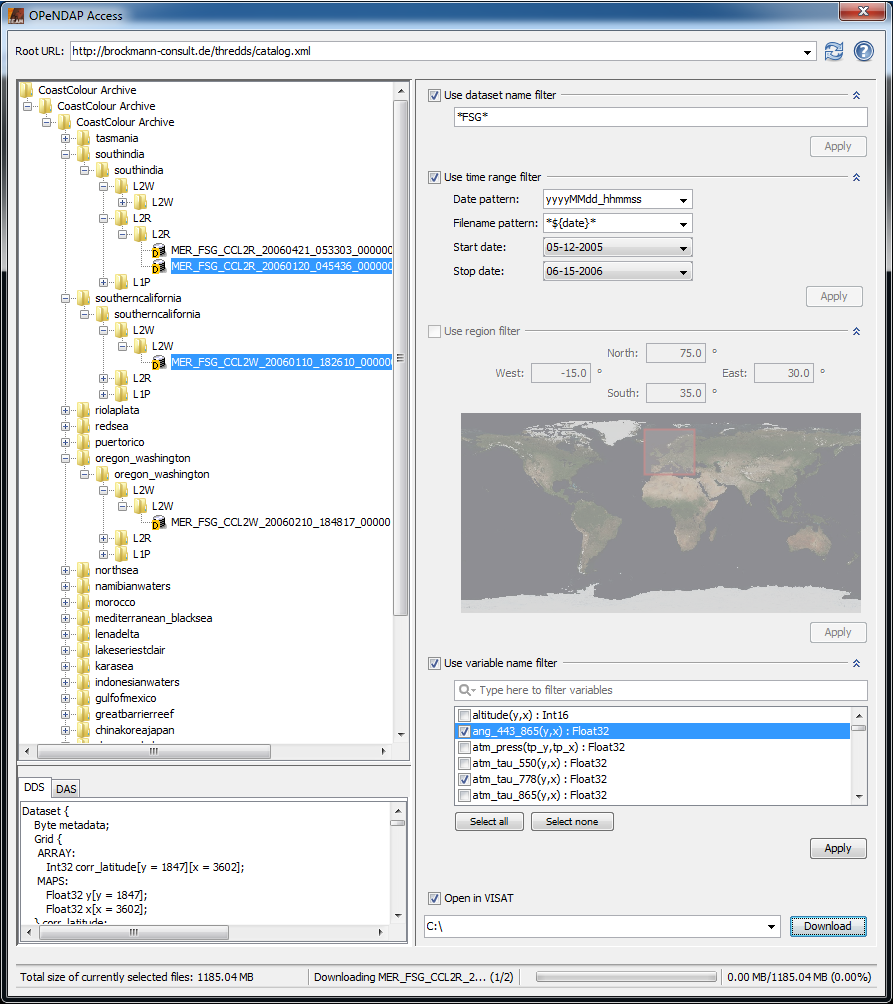
| OPeNDAP Client Overview |  |
The OPeNDAP client allows to access an OPeNDAP server and download files using the data access protocol (DAP). The client offers the possibility to filter the displayed catalog entries by various characteristics before downloading.

Server access is established by entering the URL of a THREDDS catalog file of an arbitrary OPeNDAP server in the
"Root URL"-field and typing 'Return' or clicking ![]() . The catalog content
will then be displayed
as a tree structure. The application will remember previously entered URLs.
. The catalog content
will then be displayed
as a tree structure. The application will remember previously entered URLs.
The tree structure on the left displays the contents of the chosen server.
Files which can be accessed via DAP are displayed as ![]() .
For files accessible via DAP, their DDS and DAS are displayed in the information box below the tree. For more
information about DDS and DAS please refer to http://www.opendap.org/pdf/dap_2_data_model.pdf.
.
For files accessible via DAP, their DDS and DAS are displayed in the information box below the tree. For more
information about DDS and DAS please refer to http://www.opendap.org/pdf/dap_2_data_model.pdf.
Multiple files may be selected.
The filters allow the user to narrow down the number of displayed files. A filter can be set after selecting the
respective check box. Note that the filters are not active before the apply button has been clicked.
The filters will become (in)active again after (de)selecting the check box. Multiple filters may be combined to
refine the search for files.
Using the dataset name filter a search for whole file names or parts appearing in a file name can be performed.
It supports the wildcards *, +, and ?'.
For example, if the entered filter is *2007*, only file names that contain 2007 are listed.
If the entered filter is *b+*, only file names containing at least one b in their file name.
If the entered filter is *.dima?p?, all file names with the extensions dim and dimap are listed.
The time range filter can perform a temporal restriction on the files files of the selected server.
If the chosen OPeNDAP-server provides time coverage information for its files, these information are used. If not,
the filtering is performed using the file name. In the latter case both the date pattern and the filename pattern
need to be provided by the user.
For example, the filename 'MER_RR__2PPBCM20080208_230550_000002002065_00451_31066_0001.N1' employs the
date pattern yyyyMMdd_hhmmss and features a start time, so that the filename pattern *CM${startDate}_*
should be used. The filename 'sst_northsea_20010101_20010201.nc' employs the date pattern yyyyMMdd
and features both start and stop time, so the filename pattern *_${startDate}_${endDate}* should be used.
Common pitfalls when using the time range filter:
Setting only a start time will filter out all files before the given time, setting only an end time will filter out
all files after the given time, and setting both start and end time will filter out all files not completely within
the resulting temporal range.
Files that carry no temporal information will not be filtered out.
The region filter filters out all products that do not intersect the chosen geographic region.
This filter relies on information about the files' geospatial extents.
If the OPeNDAP server does not provide geospatial information about a specific file, that file will not be affected
by
the filter.
The variable filter filters out products that do not contain certain variables.
Initially, no information about variables are available, so the filter will start scanning for variable information
when browsing through the catalog. It is applicable as soon as variable information are available.
When applied, the filter will keep all files which contain at least one of the selected variables.
The selected files are downloaded by clicking the "Download" button. When the client is run in VISAT, the products can be opened immediately after their download is complete.